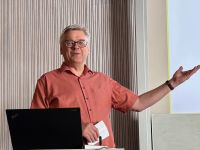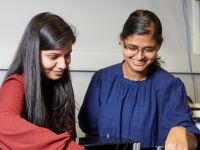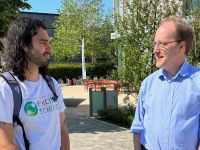
Automation and machine learning to transform the pace of renewable energy research
Exciton Science Chief Investigators Jacek Jasieniak, Udo Bach and Trevor Smith are set to embark on exciting new projects aimed at rapidly accelerating the pace of solar photovoltaics materials discovery.
The Australian Renewable Energy Agency (ARENA) will contribute vital funding to establish a $7 million world-leading facility at the Melbourne Centre for Nanofabrication to accelerate the development of new materials through both vacuum and printing processes.
ARENA has also contributed significant funds to establishing a world-class ultra-fast laser system for the spectroscopy of photovoltaic materials at The University of Melbourne.
The facilities will significantly bolster Australia’s competitiveness in the development of next-generation solar cells and solar fuels, as well as batteries and various other types of new energy technologies.
A team led by Professor Bach, Professor of Chemical Engineering at Monash University, received $3.9 million in funding to establish a dedicated High Throughput Solution-Processable Photovoltaic Materials Discovery Facility.
This materials discovery tool will bring together advanced robotics, automation and artificial intelligence concepts to rapidly synthesise, deposit and test the properties of new generations of printable and ‘paint on’ energy materials.
The facility will be able to run autonomously for 24 hours, continuously making and characterising thin film coatings. This will allow future users to speed up their experimental throughput by at least 100 times compared to conventional research practices, and will also enable students and researchers to embark on individual projects with more confidence in their long-term viability.
Ongoing research into perovskites – an emerging material for next generation solar cells – will be a major focus.
“There’s no comparable set up anywhere globally,” Professor Bach said.
“The idea is that we have a sample going through the entire process every three to five minutes. That gives us something like 2,000-3,000 samples a week if we run non-stop.
“We should have a dramatically improved sample throughput, 100-fold compared to a single operator. Whatever has taken months before could now be done in just days.
“Then the big opportunity here is also that we can integrate some machine learning, which is going to produce data sets of samples of which we know everything. Starting from how we make the sample to all the characterization parameters.
“There will be unmatched sample preparation accuracy and reproducibility. And also we will have a data archive that has full memory of anything that’s ever been done.”
Professor Jasieniak, Professor of Materials Science and Engineering and Associate Dean of Research for the Faculty of Engineering at Monash University, will seek to progress New Materials Discovery through an Advanced Sputtering Tool.
Sputtering is a process whereby nanoscopic particles of a solid material are ejected from a surface, after the material itself is hit with energised particles of plasma or gas.
It is a technique used in the manufacturing of high-precision optical coatings, semiconductor devices and nanotechnology products.
This customised system will enable combinatorial discovery of materials, where different target materials will be simultaneously mixed to provide almost unlimited material combinations.
Through its ability to rapidly deposit and characterise inorganic materials over a wide material parameter space in a single deposition step, this system can support accelerated discovery and development of materials suitable across many aspects related to photovoltaics, including new earth-abundant inorganic absorbers, interfacing transport layers, electrodes, anti-reflective coatings and protecting layers.
“The development of new materials and interfaces is critical towards future progress in silicon and other emerging photovoltaics. However, such developments are inherently unproductive and expensive,” Professor Jasieniak said.
“The proposed facility will develop a new capability in combinatorial sputtering system within Australia that will accelerate the development and optimisation of sputtered inorganic materials in a big way compared to more conventional vacuum techniques.”
Professor Trevor Smith of the University of Melbourne has received funding to establish an Ultrafast Laser System for Spectroscopy of Photovoltaic Materials.
The light-induced changes within photovoltaic devices, including silicon, organic and perovskite-based materials, occur on time-scales from tens of femtoseconds to milliseconds.
Studying the ultra-fast light-induced changes in solar cells at these speeds, including in organic and perovskite-based materials, requires fine-tuned lasers that provide light pulses of ultrashort duration at high repetition rates and which can be tuned to various wavelengths.
Understanding the changes to the behaviour of these materials after the absorption of light is key to identifying their usefulness and effectiveness in application and requires extraordinarily powerful machinery.
The new ultrafast laser amplifier system will produce pulses of light of approximately 30 femtoseconds duration at tens to hundreds of thousands of pulses per second.
Alone, and coupled with other infrastructure, the system will be used to study liquid and solid samples under a variety of conditions, and potentially down to micrometre scales.
This will further our understanding of what limits the efficiencies of current solar PV technologies and will allow for new approaches including exploiting singlet fission, luminescence solar concentration, photon up-conversion and different device structures.
Facilitated by the Australian Centre for Advanced Photovoltaics (ACAP), the ARENA-backed project has also received funding contributions from Exciton Science, Monash University, CSIRO and the Australian National Fabrication Facility.







